Research Proposal: Biomechanical Asymmetry after ACL Reconstruction
VerifiedAdded on 2022/08/21
|26
|8719
|14
Report
AI Summary
This research proposal investigates biomechanical asymmetry following Anterior Cruciate Ligament (ACL) reconstruction. The study aims to assess the impact of ACL reconstruction on biomechanics, focusing on isometric force plate analysis, stability during balance trials, and movement tasks like squats and sit-to-stand exercises. The introduction highlights the significance of ACL injuries, the importance of surgical reconstruction, and the need to understand post-operative biomechanical imbalances. The methodology includes a detailed outline of the research design, proposed analyses, and ethical considerations. The study seeks to understand the impact of ACL reconstruction on joint stability, movement patterns, and potential long-term consequences such as re-injury. The research will employ a multidisciplinary approach, incorporating biomechanical assessments to evaluate the effectiveness of rehabilitation protocols and identify potential areas for improvement in patient outcomes. The proposal also includes a comprehensive literature review that covers ACL injuries, the role of biomechanics, and the appropriateness of the research methods employed, as well as a Gantt chart outlining the project timeline.

P a g e | 1
Research Proposal: Biomechanical
Asymmetry following Anterior Cruciate
Ligament reconstruction
Research Proposal: Biomechanical
Asymmetry following Anterior Cruciate
Ligament reconstruction
Paraphrase This Document
Need a fresh take? Get an instant paraphrase of this document with our AI Paraphraser

P a g e | 2
Contents
Introduction......................................................................................................................................4
Background to the research problem...........................................................................................4
Research objectives:................................................................................................................5
Research question........................................................................................................................6
Research design and methodology..............................................................................................6
Research gaps..............................................................................................................................6
Research variables.......................................................................................................................7
Literature review..............................................................................................................................7
An overview of ACL...................................................................................................................7
Asymmetrical analysis in providing insights to submaximal walking and running gait.............8
Asymmetrical analysis and the domain of ACL reconstruction..................................................9
What ACL do patients go through?.............................................................................................9
Appropriateness of relevant research methods and data analysis..............................................11
Quality of past research methods...............................................................................................11
Validity and usefulness of past research....................................................................................12
Summary....................................................................................................................................12
Methods.........................................................................................................................................12
Aim/Hypothesis.........................................................................................................................12
Research aims:.......................................................................................................................12
Research design.........................................................................................................................12
Outline methods.........................................................................................................................13
Proposed analyses......................................................................................................................13
Expected ethical issues and strategies to mitigate them............................................................14
Gantt chart of timescales...........................................................................................................14
Contents
Introduction......................................................................................................................................4
Background to the research problem...........................................................................................4
Research objectives:................................................................................................................5
Research question........................................................................................................................6
Research design and methodology..............................................................................................6
Research gaps..............................................................................................................................6
Research variables.......................................................................................................................7
Literature review..............................................................................................................................7
An overview of ACL...................................................................................................................7
Asymmetrical analysis in providing insights to submaximal walking and running gait.............8
Asymmetrical analysis and the domain of ACL reconstruction..................................................9
What ACL do patients go through?.............................................................................................9
Appropriateness of relevant research methods and data analysis..............................................11
Quality of past research methods...............................................................................................11
Validity and usefulness of past research....................................................................................12
Summary....................................................................................................................................12
Methods.........................................................................................................................................12
Aim/Hypothesis.........................................................................................................................12
Research aims:.......................................................................................................................12
Research design.........................................................................................................................12
Outline methods.........................................................................................................................13
Proposed analyses......................................................................................................................13
Expected ethical issues and strategies to mitigate them............................................................14
Gantt chart of timescales...........................................................................................................14

P a g e | 3
Reference.......................................................................................................................................16
Reference.......................................................................................................................................16
⊘ This is a preview!⊘
Do you want full access?
Subscribe today to unlock all pages.

Trusted by 1+ million students worldwide
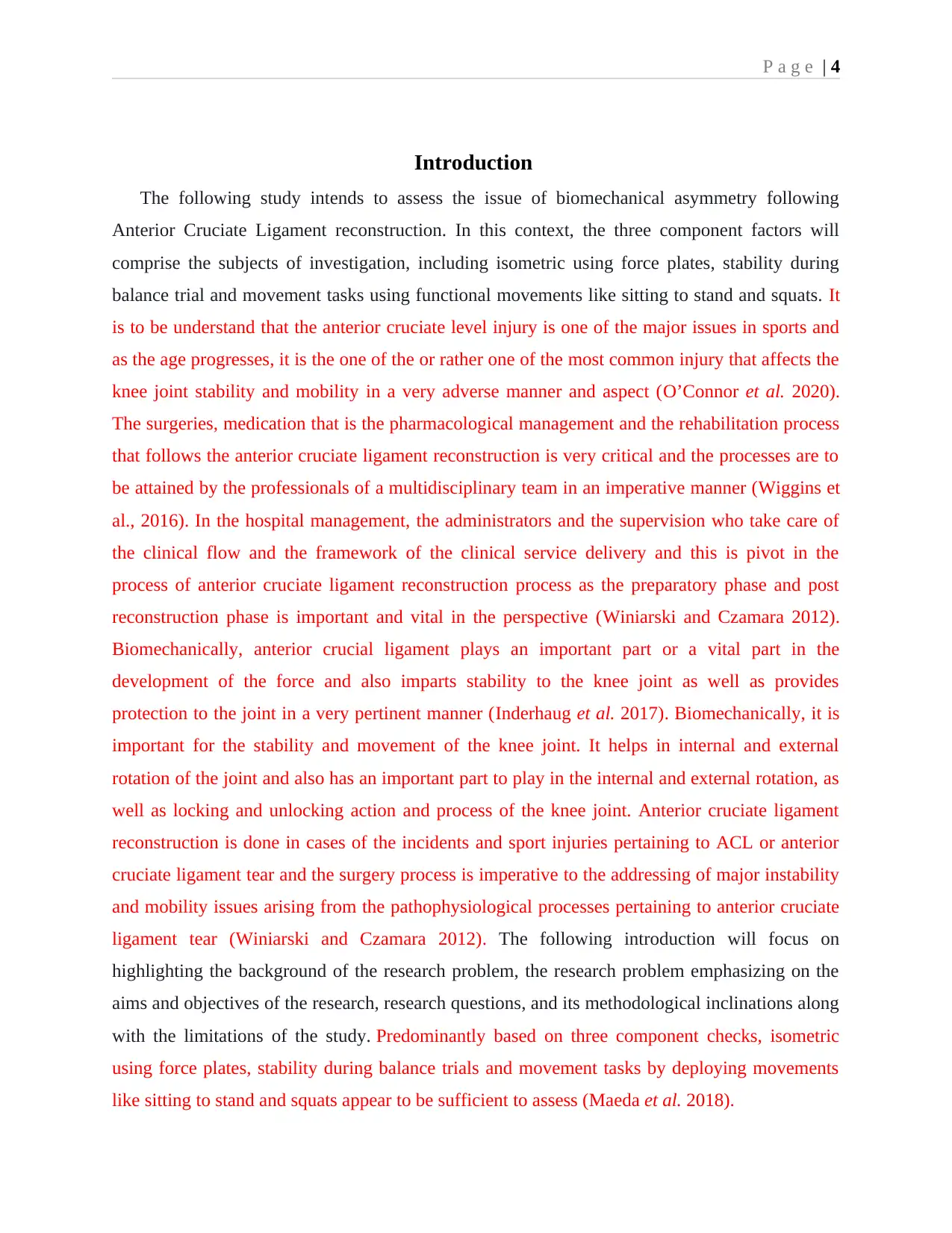
P a g e | 4
Introduction
The following study intends to assess the issue of biomechanical asymmetry following
Anterior Cruciate Ligament reconstruction. In this context, the three component factors will
comprise the subjects of investigation, including isometric using force plates, stability during
balance trial and movement tasks using functional movements like sitting to stand and squats. It
is to be understand that the anterior cruciate level injury is one of the major issues in sports and
as the age progresses, it is the one of the or rather one of the most common injury that affects the
knee joint stability and mobility in a very adverse manner and aspect (O’Connor et al. 2020).
The surgeries, medication that is the pharmacological management and the rehabilitation process
that follows the anterior cruciate ligament reconstruction is very critical and the processes are to
be attained by the professionals of a multidisciplinary team in an imperative manner (Wiggins et
al., 2016). In the hospital management, the administrators and the supervision who take care of
the clinical flow and the framework of the clinical service delivery and this is pivot in the
process of anterior cruciate ligament reconstruction process as the preparatory phase and post
reconstruction phase is important and vital in the perspective (Winiarski and Czamara 2012).
Biomechanically, anterior crucial ligament plays an important part or a vital part in the
development of the force and also imparts stability to the knee joint as well as provides
protection to the joint in a very pertinent manner (Inderhaug et al. 2017). Biomechanically, it is
important for the stability and movement of the knee joint. It helps in internal and external
rotation of the joint and also has an important part to play in the internal and external rotation, as
well as locking and unlocking action and process of the knee joint. Anterior cruciate ligament
reconstruction is done in cases of the incidents and sport injuries pertaining to ACL or anterior
cruciate ligament tear and the surgery process is imperative to the addressing of major instability
and mobility issues arising from the pathophysiological processes pertaining to anterior cruciate
ligament tear (Winiarski and Czamara 2012). The following introduction will focus on
highlighting the background of the research problem, the research problem emphasizing on the
aims and objectives of the research, research questions, and its methodological inclinations along
with the limitations of the study. Predominantly based on three component checks, isometric
using force plates, stability during balance trials and movement tasks by deploying movements
like sitting to stand and squats appear to be sufficient to assess (Maeda et al. 2018).
Introduction
The following study intends to assess the issue of biomechanical asymmetry following
Anterior Cruciate Ligament reconstruction. In this context, the three component factors will
comprise the subjects of investigation, including isometric using force plates, stability during
balance trial and movement tasks using functional movements like sitting to stand and squats. It
is to be understand that the anterior cruciate level injury is one of the major issues in sports and
as the age progresses, it is the one of the or rather one of the most common injury that affects the
knee joint stability and mobility in a very adverse manner and aspect (O’Connor et al. 2020).
The surgeries, medication that is the pharmacological management and the rehabilitation process
that follows the anterior cruciate ligament reconstruction is very critical and the processes are to
be attained by the professionals of a multidisciplinary team in an imperative manner (Wiggins et
al., 2016). In the hospital management, the administrators and the supervision who take care of
the clinical flow and the framework of the clinical service delivery and this is pivot in the
process of anterior cruciate ligament reconstruction process as the preparatory phase and post
reconstruction phase is important and vital in the perspective (Winiarski and Czamara 2012).
Biomechanically, anterior crucial ligament plays an important part or a vital part in the
development of the force and also imparts stability to the knee joint as well as provides
protection to the joint in a very pertinent manner (Inderhaug et al. 2017). Biomechanically, it is
important for the stability and movement of the knee joint. It helps in internal and external
rotation of the joint and also has an important part to play in the internal and external rotation, as
well as locking and unlocking action and process of the knee joint. Anterior cruciate ligament
reconstruction is done in cases of the incidents and sport injuries pertaining to ACL or anterior
cruciate ligament tear and the surgery process is imperative to the addressing of major instability
and mobility issues arising from the pathophysiological processes pertaining to anterior cruciate
ligament tear (Winiarski and Czamara 2012). The following introduction will focus on
highlighting the background of the research problem, the research problem emphasizing on the
aims and objectives of the research, research questions, and its methodological inclinations along
with the limitations of the study. Predominantly based on three component checks, isometric
using force plates, stability during balance trials and movement tasks by deploying movements
like sitting to stand and squats appear to be sufficient to assess (Maeda et al. 2018).
Paraphrase This Document
Need a fresh take? Get an instant paraphrase of this document with our AI Paraphraser
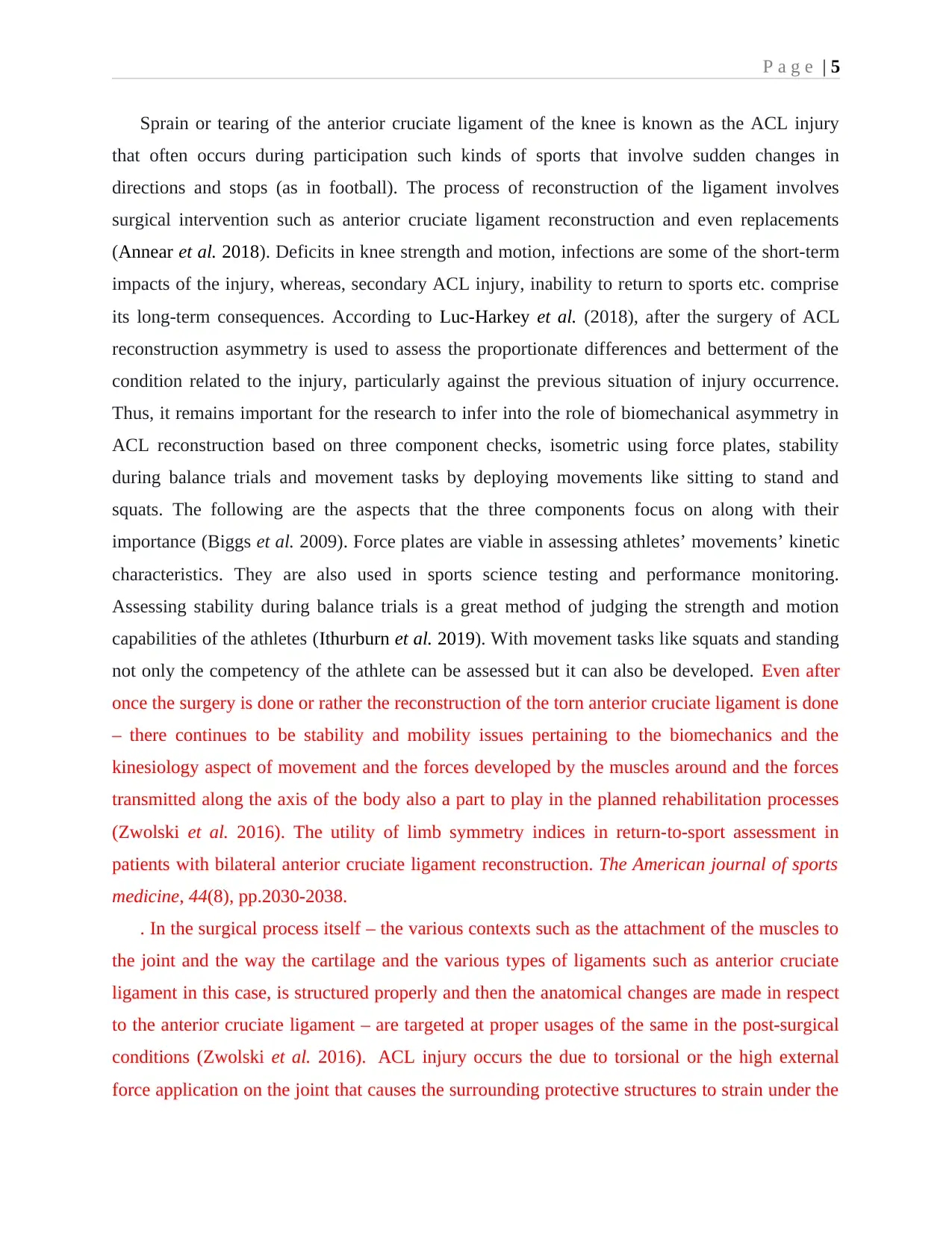
P a g e | 5
Sprain or tearing of the anterior cruciate ligament of the knee is known as the ACL injury
that often occurs during participation such kinds of sports that involve sudden changes in
directions and stops (as in football). The process of reconstruction of the ligament involves
surgical intervention such as anterior cruciate ligament reconstruction and even replacements
(Annear et al. 2018). Deficits in knee strength and motion, infections are some of the short-term
impacts of the injury, whereas, secondary ACL injury, inability to return to sports etc. comprise
its long-term consequences. According to Luc-Harkey et al. (2018), after the surgery of ACL
reconstruction asymmetry is used to assess the proportionate differences and betterment of the
condition related to the injury, particularly against the previous situation of injury occurrence.
Thus, it remains important for the research to infer into the role of biomechanical asymmetry in
ACL reconstruction based on three component checks, isometric using force plates, stability
during balance trials and movement tasks by deploying movements like sitting to stand and
squats. The following are the aspects that the three components focus on along with their
importance (Biggs et al. 2009). Force plates are viable in assessing athletes’ movements’ kinetic
characteristics. They are also used in sports science testing and performance monitoring.
Assessing stability during balance trials is a great method of judging the strength and motion
capabilities of the athletes (Ithurburn et al. 2019). With movement tasks like squats and standing
not only the competency of the athlete can be assessed but it can also be developed. Even after
once the surgery is done or rather the reconstruction of the torn anterior cruciate ligament is done
– there continues to be stability and mobility issues pertaining to the biomechanics and the
kinesiology aspect of movement and the forces developed by the muscles around and the forces
transmitted along the axis of the body also a part to play in the planned rehabilitation processes
(Zwolski et al. 2016). The utility of limb symmetry indices in return-to-sport assessment in
patients with bilateral anterior cruciate ligament reconstruction. The American journal of sports
medicine, 44(8), pp.2030-2038.
. In the surgical process itself – the various contexts such as the attachment of the muscles to
the joint and the way the cartilage and the various types of ligaments such as anterior cruciate
ligament in this case, is structured properly and then the anatomical changes are made in respect
to the anterior cruciate ligament – are targeted at proper usages of the same in the post-surgical
conditions (Zwolski et al. 2016). ACL injury occurs the due to torsional or the high external
force application on the joint that causes the surrounding protective structures to strain under the
Sprain or tearing of the anterior cruciate ligament of the knee is known as the ACL injury
that often occurs during participation such kinds of sports that involve sudden changes in
directions and stops (as in football). The process of reconstruction of the ligament involves
surgical intervention such as anterior cruciate ligament reconstruction and even replacements
(Annear et al. 2018). Deficits in knee strength and motion, infections are some of the short-term
impacts of the injury, whereas, secondary ACL injury, inability to return to sports etc. comprise
its long-term consequences. According to Luc-Harkey et al. (2018), after the surgery of ACL
reconstruction asymmetry is used to assess the proportionate differences and betterment of the
condition related to the injury, particularly against the previous situation of injury occurrence.
Thus, it remains important for the research to infer into the role of biomechanical asymmetry in
ACL reconstruction based on three component checks, isometric using force plates, stability
during balance trials and movement tasks by deploying movements like sitting to stand and
squats. The following are the aspects that the three components focus on along with their
importance (Biggs et al. 2009). Force plates are viable in assessing athletes’ movements’ kinetic
characteristics. They are also used in sports science testing and performance monitoring.
Assessing stability during balance trials is a great method of judging the strength and motion
capabilities of the athletes (Ithurburn et al. 2019). With movement tasks like squats and standing
not only the competency of the athlete can be assessed but it can also be developed. Even after
once the surgery is done or rather the reconstruction of the torn anterior cruciate ligament is done
– there continues to be stability and mobility issues pertaining to the biomechanics and the
kinesiology aspect of movement and the forces developed by the muscles around and the forces
transmitted along the axis of the body also a part to play in the planned rehabilitation processes
(Zwolski et al. 2016). The utility of limb symmetry indices in return-to-sport assessment in
patients with bilateral anterior cruciate ligament reconstruction. The American journal of sports
medicine, 44(8), pp.2030-2038.
. In the surgical process itself – the various contexts such as the attachment of the muscles to
the joint and the way the cartilage and the various types of ligaments such as anterior cruciate
ligament in this case, is structured properly and then the anatomical changes are made in respect
to the anterior cruciate ligament – are targeted at proper usages of the same in the post-surgical
conditions (Zwolski et al. 2016). ACL injury occurs the due to torsional or the high external
force application on the joint that causes the surrounding protective structures to strain under the
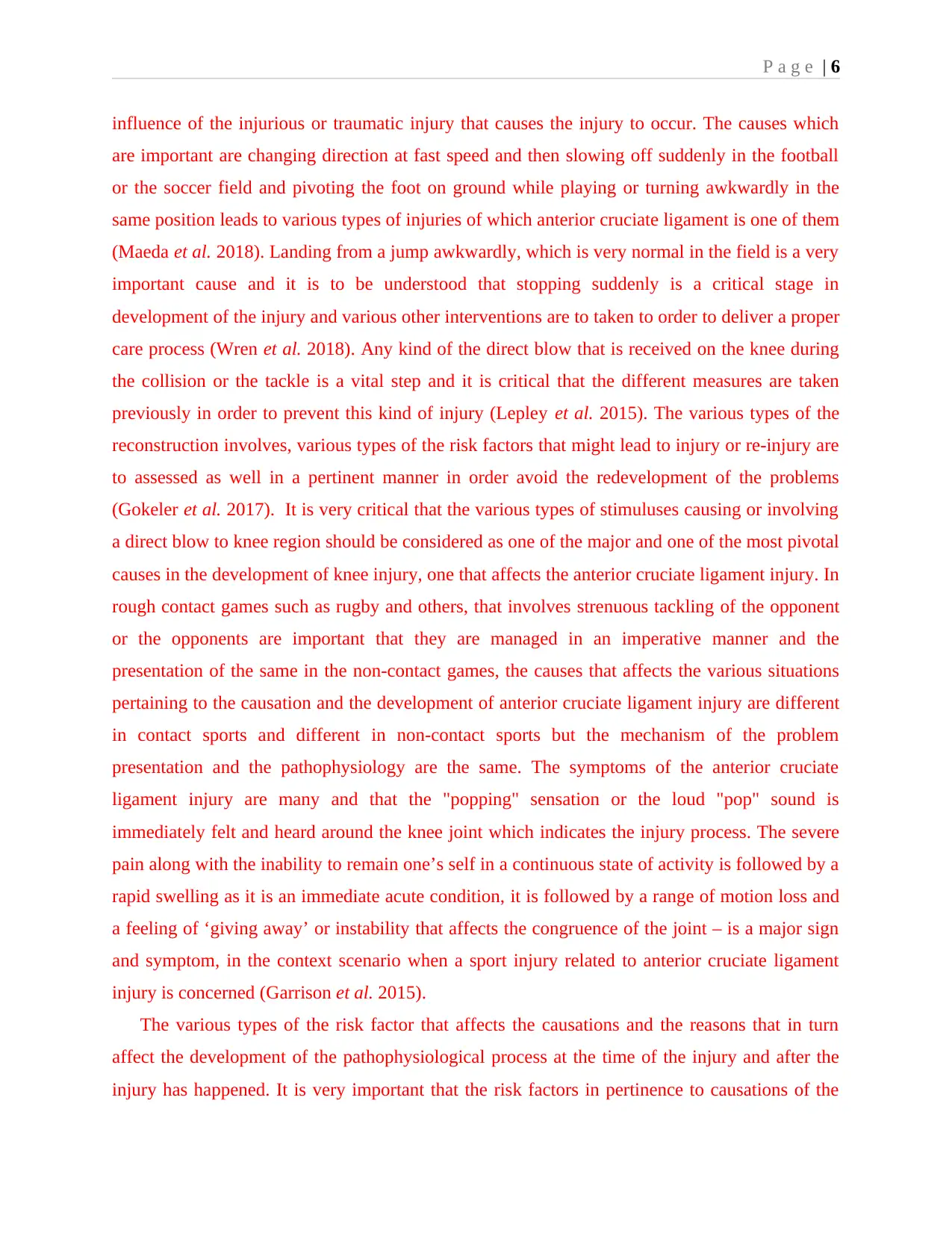
P a g e | 6
influence of the injurious or traumatic injury that causes the injury to occur. The causes which
are important are changing direction at fast speed and then slowing off suddenly in the football
or the soccer field and pivoting the foot on ground while playing or turning awkwardly in the
same position leads to various types of injuries of which anterior cruciate ligament is one of them
(Maeda et al. 2018). Landing from a jump awkwardly, which is very normal in the field is a very
important cause and it is to be understood that stopping suddenly is a critical stage in
development of the injury and various other interventions are to taken to order to deliver a proper
care process (Wren et al. 2018). Any kind of the direct blow that is received on the knee during
the collision or the tackle is a vital step and it is critical that the different measures are taken
previously in order to prevent this kind of injury (Lepley et al. 2015). The various types of the
reconstruction involves, various types of the risk factors that might lead to injury or re-injury are
to assessed as well in a pertinent manner in order avoid the redevelopment of the problems
(Gokeler et al. 2017). It is very critical that the various types of stimuluses causing or involving
a direct blow to knee region should be considered as one of the major and one of the most pivotal
causes in the development of knee injury, one that affects the anterior cruciate ligament injury. In
rough contact games such as rugby and others, that involves strenuous tackling of the opponent
or the opponents are important that they are managed in an imperative manner and the
presentation of the same in the non-contact games, the causes that affects the various situations
pertaining to the causation and the development of anterior cruciate ligament injury are different
in contact sports and different in non-contact sports but the mechanism of the problem
presentation and the pathophysiology are the same. The symptoms of the anterior cruciate
ligament injury are many and that the "popping" sensation or the loud "pop" sound is
immediately felt and heard around the knee joint which indicates the injury process. The severe
pain along with the inability to remain one’s self in a continuous state of activity is followed by a
rapid swelling as it is an immediate acute condition, it is followed by a range of motion loss and
a feeling of ‘giving away’ or instability that affects the congruence of the joint – is a major sign
and symptom, in the context scenario when a sport injury related to anterior cruciate ligament
injury is concerned (Garrison et al. 2015).
The various types of the risk factor that affects the causations and the reasons that in turn
affect the development of the pathophysiological process at the time of the injury and after the
injury has happened. It is very important that the risk factors in pertinence to causations of the
influence of the injurious or traumatic injury that causes the injury to occur. The causes which
are important are changing direction at fast speed and then slowing off suddenly in the football
or the soccer field and pivoting the foot on ground while playing or turning awkwardly in the
same position leads to various types of injuries of which anterior cruciate ligament is one of them
(Maeda et al. 2018). Landing from a jump awkwardly, which is very normal in the field is a very
important cause and it is to be understood that stopping suddenly is a critical stage in
development of the injury and various other interventions are to taken to order to deliver a proper
care process (Wren et al. 2018). Any kind of the direct blow that is received on the knee during
the collision or the tackle is a vital step and it is critical that the different measures are taken
previously in order to prevent this kind of injury (Lepley et al. 2015). The various types of the
reconstruction involves, various types of the risk factors that might lead to injury or re-injury are
to assessed as well in a pertinent manner in order avoid the redevelopment of the problems
(Gokeler et al. 2017). It is very critical that the various types of stimuluses causing or involving
a direct blow to knee region should be considered as one of the major and one of the most pivotal
causes in the development of knee injury, one that affects the anterior cruciate ligament injury. In
rough contact games such as rugby and others, that involves strenuous tackling of the opponent
or the opponents are important that they are managed in an imperative manner and the
presentation of the same in the non-contact games, the causes that affects the various situations
pertaining to the causation and the development of anterior cruciate ligament injury are different
in contact sports and different in non-contact sports but the mechanism of the problem
presentation and the pathophysiology are the same. The symptoms of the anterior cruciate
ligament injury are many and that the "popping" sensation or the loud "pop" sound is
immediately felt and heard around the knee joint which indicates the injury process. The severe
pain along with the inability to remain one’s self in a continuous state of activity is followed by a
rapid swelling as it is an immediate acute condition, it is followed by a range of motion loss and
a feeling of ‘giving away’ or instability that affects the congruence of the joint – is a major sign
and symptom, in the context scenario when a sport injury related to anterior cruciate ligament
injury is concerned (Garrison et al. 2015).
The various types of the risk factor that affects the causations and the reasons that in turn
affect the development of the pathophysiological process at the time of the injury and after the
injury has happened. It is very important that the risk factors in pertinence to causations of the
⊘ This is a preview!⊘
Do you want full access?
Subscribe today to unlock all pages.

Trusted by 1+ million students worldwide
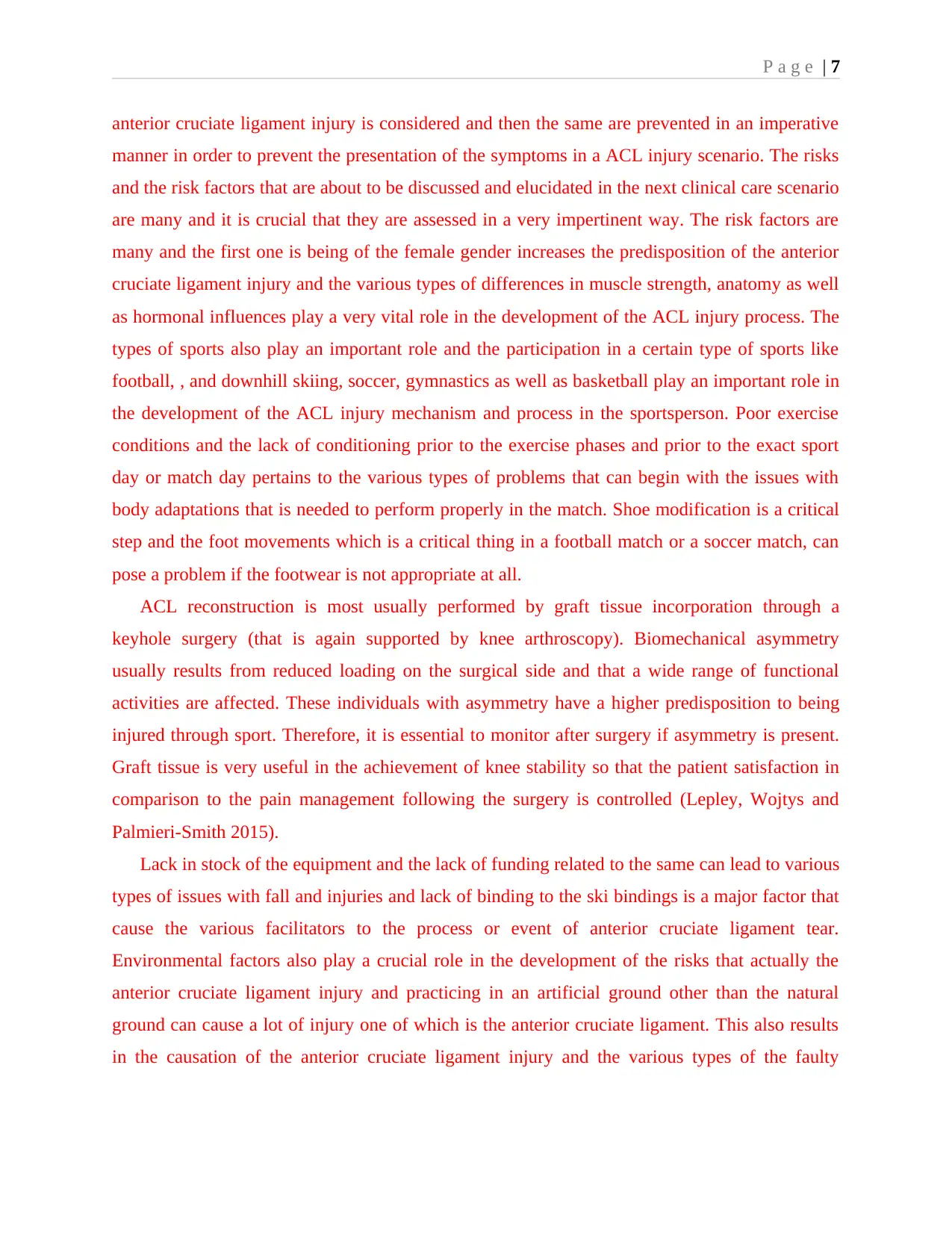
P a g e | 7
anterior cruciate ligament injury is considered and then the same are prevented in an imperative
manner in order to prevent the presentation of the symptoms in a ACL injury scenario. The risks
and the risk factors that are about to be discussed and elucidated in the next clinical care scenario
are many and it is crucial that they are assessed in a very impertinent way. The risk factors are
many and the first one is being of the female gender increases the predisposition of the anterior
cruciate ligament injury and the various types of differences in muscle strength, anatomy as well
as hormonal influences play a very vital role in the development of the ACL injury process. The
types of sports also play an important role and the participation in a certain type of sports like
football, , and downhill skiing, soccer, gymnastics as well as basketball play an important role in
the development of the ACL injury mechanism and process in the sportsperson. Poor exercise
conditions and the lack of conditioning prior to the exercise phases and prior to the exact sport
day or match day pertains to the various types of problems that can begin with the issues with
body adaptations that is needed to perform properly in the match. Shoe modification is a critical
step and the foot movements which is a critical thing in a football match or a soccer match, can
pose a problem if the footwear is not appropriate at all.
ACL reconstruction is most usually performed by graft tissue incorporation through a
keyhole surgery (that is again supported by knee arthroscopy). Biomechanical asymmetry
usually results from reduced loading on the surgical side and that a wide range of functional
activities are affected. These individuals with asymmetry have a higher predisposition to being
injured through sport. Therefore, it is essential to monitor after surgery if asymmetry is present.
Graft tissue is very useful in the achievement of knee stability so that the patient satisfaction in
comparison to the pain management following the surgery is controlled (Lepley, Wojtys and
Palmieri-Smith 2015).
Lack in stock of the equipment and the lack of funding related to the same can lead to various
types of issues with fall and injuries and lack of binding to the ski bindings is a major factor that
cause the various facilitators to the process or event of anterior cruciate ligament tear.
Environmental factors also play a crucial role in the development of the risks that actually the
anterior cruciate ligament injury and practicing in an artificial ground other than the natural
ground can cause a lot of injury one of which is the anterior cruciate ligament. This also results
in the causation of the anterior cruciate ligament injury and the various types of the faulty
anterior cruciate ligament injury is considered and then the same are prevented in an imperative
manner in order to prevent the presentation of the symptoms in a ACL injury scenario. The risks
and the risk factors that are about to be discussed and elucidated in the next clinical care scenario
are many and it is crucial that they are assessed in a very impertinent way. The risk factors are
many and the first one is being of the female gender increases the predisposition of the anterior
cruciate ligament injury and the various types of differences in muscle strength, anatomy as well
as hormonal influences play a very vital role in the development of the ACL injury process. The
types of sports also play an important role and the participation in a certain type of sports like
football, , and downhill skiing, soccer, gymnastics as well as basketball play an important role in
the development of the ACL injury mechanism and process in the sportsperson. Poor exercise
conditions and the lack of conditioning prior to the exercise phases and prior to the exact sport
day or match day pertains to the various types of problems that can begin with the issues with
body adaptations that is needed to perform properly in the match. Shoe modification is a critical
step and the foot movements which is a critical thing in a football match or a soccer match, can
pose a problem if the footwear is not appropriate at all.
ACL reconstruction is most usually performed by graft tissue incorporation through a
keyhole surgery (that is again supported by knee arthroscopy). Biomechanical asymmetry
usually results from reduced loading on the surgical side and that a wide range of functional
activities are affected. These individuals with asymmetry have a higher predisposition to being
injured through sport. Therefore, it is essential to monitor after surgery if asymmetry is present.
Graft tissue is very useful in the achievement of knee stability so that the patient satisfaction in
comparison to the pain management following the surgery is controlled (Lepley, Wojtys and
Palmieri-Smith 2015).
Lack in stock of the equipment and the lack of funding related to the same can lead to various
types of issues with fall and injuries and lack of binding to the ski bindings is a major factor that
cause the various facilitators to the process or event of anterior cruciate ligament tear.
Environmental factors also play a crucial role in the development of the risks that actually the
anterior cruciate ligament injury and practicing in an artificial ground other than the natural
ground can cause a lot of injury one of which is the anterior cruciate ligament. This also results
in the causation of the anterior cruciate ligament injury and the various types of the faulty
Paraphrase This Document
Need a fresh take? Get an instant paraphrase of this document with our AI Paraphraser

P a g e | 8
equipment that are used in the training sessions and the lack of good footwear from the training
session can lead to the injury as well (Logerstedt et al. 2013).
There are certain risk factors of the injury that are already been mentioned above and the
ligament is reconstructed by the orthopedic surgeons and patient is important that the various
type of nursing interventions as well as pharmacological and pre operational interventions are
required to be done in the clinical scenario and once, the surgery or the ligament of anterior
cruciate ligament is reconstructed, the physical therapy process is undertaken that is required to
train the movements, the required movements to be specific and the pain is to be controlled as
well. The nursing intervention is to the control of effusion and the control of pain or bleeding in
or around the reconstructed area of the patient is important and there can be various number of
barriers that is applicable and present in this stage that can then lead to the causation of the re-
trauma of the affected anterior cruciate ligament region. Re-trauma can result from development
of excessive effusion and the opening of the sutures as well direct blow or lack of proper
bandaging as well as the proper type of the precautions if not taken would help and assist in the
re-traumatization process, causing more problems to the patient and the clinical health care team
in a severe context.
The asymmetry values with context to the healthy and patient groups are to be assessed
pertinently by clinical health care team. It is to be understood that the various type of the
congruency issues are many and there are different types of the alignment problems that follows
the reconstruction procedure – are to be assessed in a pertinent manner. It is to be assessed by the
health care team that there are alignment issues with the subject which results from cross union,
malunion and delayed union that can cause the ligament to get healed in a late way or
inappropriate manner. The other problems that are associated with anterior cruciate ligament
injury and reconstruction can be scarring and uncontrolled cartilage formation that can again lead
to re-trauma and formation of more adverse barriers hindering the bone growth and joint laxity
as well joint surface congruency plus joint integrity in a very different manner. That would then
again add to complex management of the additional issues thus, adversely affecting the
prognosis. Previous research has shown that the assessment of biomechanical asymmetry can
provide feasible insights regarding submaximal walking and running gaits (Burlandet al. 2019).
Asymmetries associated with the motion of the knee are considered to be a viable risk factor for
second Anterior Cruciate Ligament (ACL) injury (Ebert et al. 2018). Thus, it becomes relevant
equipment that are used in the training sessions and the lack of good footwear from the training
session can lead to the injury as well (Logerstedt et al. 2013).
There are certain risk factors of the injury that are already been mentioned above and the
ligament is reconstructed by the orthopedic surgeons and patient is important that the various
type of nursing interventions as well as pharmacological and pre operational interventions are
required to be done in the clinical scenario and once, the surgery or the ligament of anterior
cruciate ligament is reconstructed, the physical therapy process is undertaken that is required to
train the movements, the required movements to be specific and the pain is to be controlled as
well. The nursing intervention is to the control of effusion and the control of pain or bleeding in
or around the reconstructed area of the patient is important and there can be various number of
barriers that is applicable and present in this stage that can then lead to the causation of the re-
trauma of the affected anterior cruciate ligament region. Re-trauma can result from development
of excessive effusion and the opening of the sutures as well direct blow or lack of proper
bandaging as well as the proper type of the precautions if not taken would help and assist in the
re-traumatization process, causing more problems to the patient and the clinical health care team
in a severe context.
The asymmetry values with context to the healthy and patient groups are to be assessed
pertinently by clinical health care team. It is to be understood that the various type of the
congruency issues are many and there are different types of the alignment problems that follows
the reconstruction procedure – are to be assessed in a pertinent manner. It is to be assessed by the
health care team that there are alignment issues with the subject which results from cross union,
malunion and delayed union that can cause the ligament to get healed in a late way or
inappropriate manner. The other problems that are associated with anterior cruciate ligament
injury and reconstruction can be scarring and uncontrolled cartilage formation that can again lead
to re-trauma and formation of more adverse barriers hindering the bone growth and joint laxity
as well joint surface congruency plus joint integrity in a very different manner. That would then
again add to complex management of the additional issues thus, adversely affecting the
prognosis. Previous research has shown that the assessment of biomechanical asymmetry can
provide feasible insights regarding submaximal walking and running gaits (Burlandet al. 2019).
Asymmetries associated with the motion of the knee are considered to be a viable risk factor for
second Anterior Cruciate Ligament (ACL) injury (Ebert et al. 2018). Thus, it becomes relevant
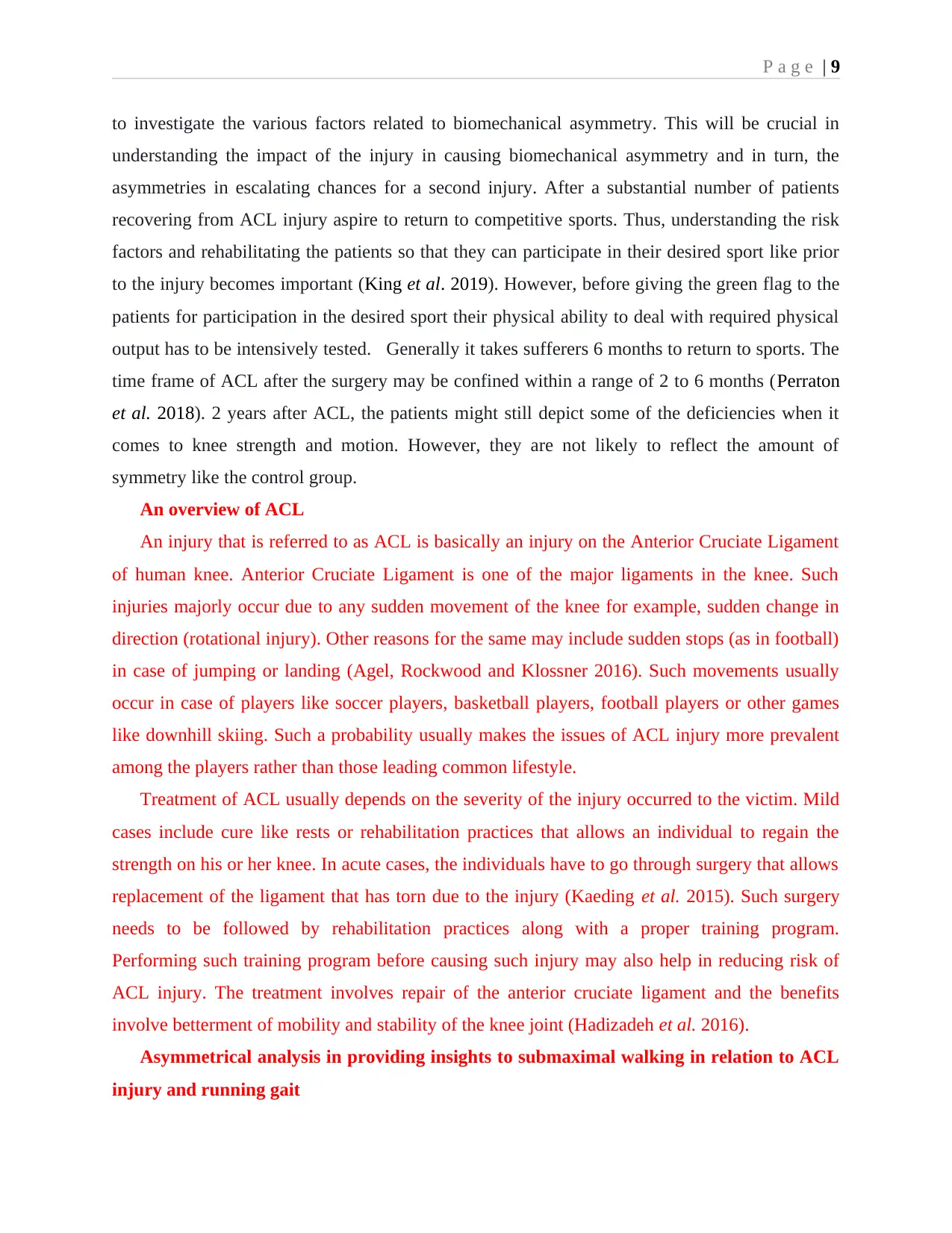
P a g e | 9
to investigate the various factors related to biomechanical asymmetry. This will be crucial in
understanding the impact of the injury in causing biomechanical asymmetry and in turn, the
asymmetries in escalating chances for a second injury. After a substantial number of patients
recovering from ACL injury aspire to return to competitive sports. Thus, understanding the risk
factors and rehabilitating the patients so that they can participate in their desired sport like prior
to the injury becomes important (King et al. 2019). However, before giving the green flag to the
patients for participation in the desired sport their physical ability to deal with required physical
output has to be intensively tested. Generally it takes sufferers 6 months to return to sports. The
time frame of ACL after the surgery may be confined within a range of 2 to 6 months (Perraton
et al. 2018). 2 years after ACL, the patients might still depict some of the deficiencies when it
comes to knee strength and motion. However, they are not likely to reflect the amount of
symmetry like the control group.
An overview of ACL
An injury that is referred to as ACL is basically an injury on the Anterior Cruciate Ligament
of human knee. Anterior Cruciate Ligament is one of the major ligaments in the knee. Such
injuries majorly occur due to any sudden movement of the knee for example, sudden change in
direction (rotational injury). Other reasons for the same may include sudden stops (as in football)
in case of jumping or landing (Agel, Rockwood and Klossner 2016). Such movements usually
occur in case of players like soccer players, basketball players, football players or other games
like downhill skiing. Such a probability usually makes the issues of ACL injury more prevalent
among the players rather than those leading common lifestyle.
Treatment of ACL usually depends on the severity of the injury occurred to the victim. Mild
cases include cure like rests or rehabilitation practices that allows an individual to regain the
strength on his or her knee. In acute cases, the individuals have to go through surgery that allows
replacement of the ligament that has torn due to the injury (Kaeding et al. 2015). Such surgery
needs to be followed by rehabilitation practices along with a proper training program.
Performing such training program before causing such injury may also help in reducing risk of
ACL injury. The treatment involves repair of the anterior cruciate ligament and the benefits
involve betterment of mobility and stability of the knee joint (Hadizadeh et al. 2016).
Asymmetrical analysis in providing insights to submaximal walking in relation to ACL
injury and running gait
to investigate the various factors related to biomechanical asymmetry. This will be crucial in
understanding the impact of the injury in causing biomechanical asymmetry and in turn, the
asymmetries in escalating chances for a second injury. After a substantial number of patients
recovering from ACL injury aspire to return to competitive sports. Thus, understanding the risk
factors and rehabilitating the patients so that they can participate in their desired sport like prior
to the injury becomes important (King et al. 2019). However, before giving the green flag to the
patients for participation in the desired sport their physical ability to deal with required physical
output has to be intensively tested. Generally it takes sufferers 6 months to return to sports. The
time frame of ACL after the surgery may be confined within a range of 2 to 6 months (Perraton
et al. 2018). 2 years after ACL, the patients might still depict some of the deficiencies when it
comes to knee strength and motion. However, they are not likely to reflect the amount of
symmetry like the control group.
An overview of ACL
An injury that is referred to as ACL is basically an injury on the Anterior Cruciate Ligament
of human knee. Anterior Cruciate Ligament is one of the major ligaments in the knee. Such
injuries majorly occur due to any sudden movement of the knee for example, sudden change in
direction (rotational injury). Other reasons for the same may include sudden stops (as in football)
in case of jumping or landing (Agel, Rockwood and Klossner 2016). Such movements usually
occur in case of players like soccer players, basketball players, football players or other games
like downhill skiing. Such a probability usually makes the issues of ACL injury more prevalent
among the players rather than those leading common lifestyle.
Treatment of ACL usually depends on the severity of the injury occurred to the victim. Mild
cases include cure like rests or rehabilitation practices that allows an individual to regain the
strength on his or her knee. In acute cases, the individuals have to go through surgery that allows
replacement of the ligament that has torn due to the injury (Kaeding et al. 2015). Such surgery
needs to be followed by rehabilitation practices along with a proper training program.
Performing such training program before causing such injury may also help in reducing risk of
ACL injury. The treatment involves repair of the anterior cruciate ligament and the benefits
involve betterment of mobility and stability of the knee joint (Hadizadeh et al. 2016).
Asymmetrical analysis in providing insights to submaximal walking in relation to ACL
injury and running gait
⊘ This is a preview!⊘
Do you want full access?
Subscribe today to unlock all pages.

Trusted by 1+ million students worldwide

P a g e | 10
Sprinting, submaximal walking and running gait can be studied in relation to ACL injury. It
may be mentioned that due to the constraints of data collection (such as positioning of the
scanners or cameras) have enabled limited procurement of actionable data with reference to
sprint running that can cause anterior cruciate ligament injury for a period of exercise. Group
based analysis, according to Nagelli et al. (2018), procures the risks of the generation of
‘mythical’ average performance data. This data can be understood as the combination of data
from both sides which can collude the outcomes of the assessment. Performance, injury, and
sports technology are some of the domains that have been highly influenced by biomechanical
asymmetry assessment. There are considerable differences between the values of the left and the
right side of the body in terms of submaximal running’s kinematic and kinetic variables. As
opined by Chang et al. (2019), based on the bilateral performance differences, the nature of any
athlete’s training can be informed by the knowledge of asymmetry, from the perspective of
coaching (Shelbourne amd Klotz 2006).
Research problem: The research problem associated with the study of biomechanical
asymmetry post-ACL reconstruction relates to the feasibility of this assessment in judging the
condition of the patients. However, addressing their effectiveness in reaching the right verdict
also links with the research problem.
Research aim
The following research aims to compare biomechanical asymmetry following ACL injury
reconstruction between ACLR and Control group focusing on the health condition of the patients
of ACL in question. With the pivotal aim of understanding the generalized impact of the
assessment with three of the aforementioned checks, the study also aims to assess the issue, in
connection with the ACL injury sufferers who belong from a background of competitive sport.
(Garrison et al. 2015).
Research objectives:
The research objectives associated with the research are as follows.
Collecting biomechanical data for the ACLR and the Control group.
Calculating data for the ACLR and the Control group.
Sprinting, submaximal walking and running gait can be studied in relation to ACL injury. It
may be mentioned that due to the constraints of data collection (such as positioning of the
scanners or cameras) have enabled limited procurement of actionable data with reference to
sprint running that can cause anterior cruciate ligament injury for a period of exercise. Group
based analysis, according to Nagelli et al. (2018), procures the risks of the generation of
‘mythical’ average performance data. This data can be understood as the combination of data
from both sides which can collude the outcomes of the assessment. Performance, injury, and
sports technology are some of the domains that have been highly influenced by biomechanical
asymmetry assessment. There are considerable differences between the values of the left and the
right side of the body in terms of submaximal running’s kinematic and kinetic variables. As
opined by Chang et al. (2019), based on the bilateral performance differences, the nature of any
athlete’s training can be informed by the knowledge of asymmetry, from the perspective of
coaching (Shelbourne amd Klotz 2006).
Research problem: The research problem associated with the study of biomechanical
asymmetry post-ACL reconstruction relates to the feasibility of this assessment in judging the
condition of the patients. However, addressing their effectiveness in reaching the right verdict
also links with the research problem.
Research aim
The following research aims to compare biomechanical asymmetry following ACL injury
reconstruction between ACLR and Control group focusing on the health condition of the patients
of ACL in question. With the pivotal aim of understanding the generalized impact of the
assessment with three of the aforementioned checks, the study also aims to assess the issue, in
connection with the ACL injury sufferers who belong from a background of competitive sport.
(Garrison et al. 2015).
Research objectives:
The research objectives associated with the research are as follows.
Collecting biomechanical data for the ACLR and the Control group.
Calculating data for the ACLR and the Control group.
Paraphrase This Document
Need a fresh take? Get an instant paraphrase of this document with our AI Paraphraser
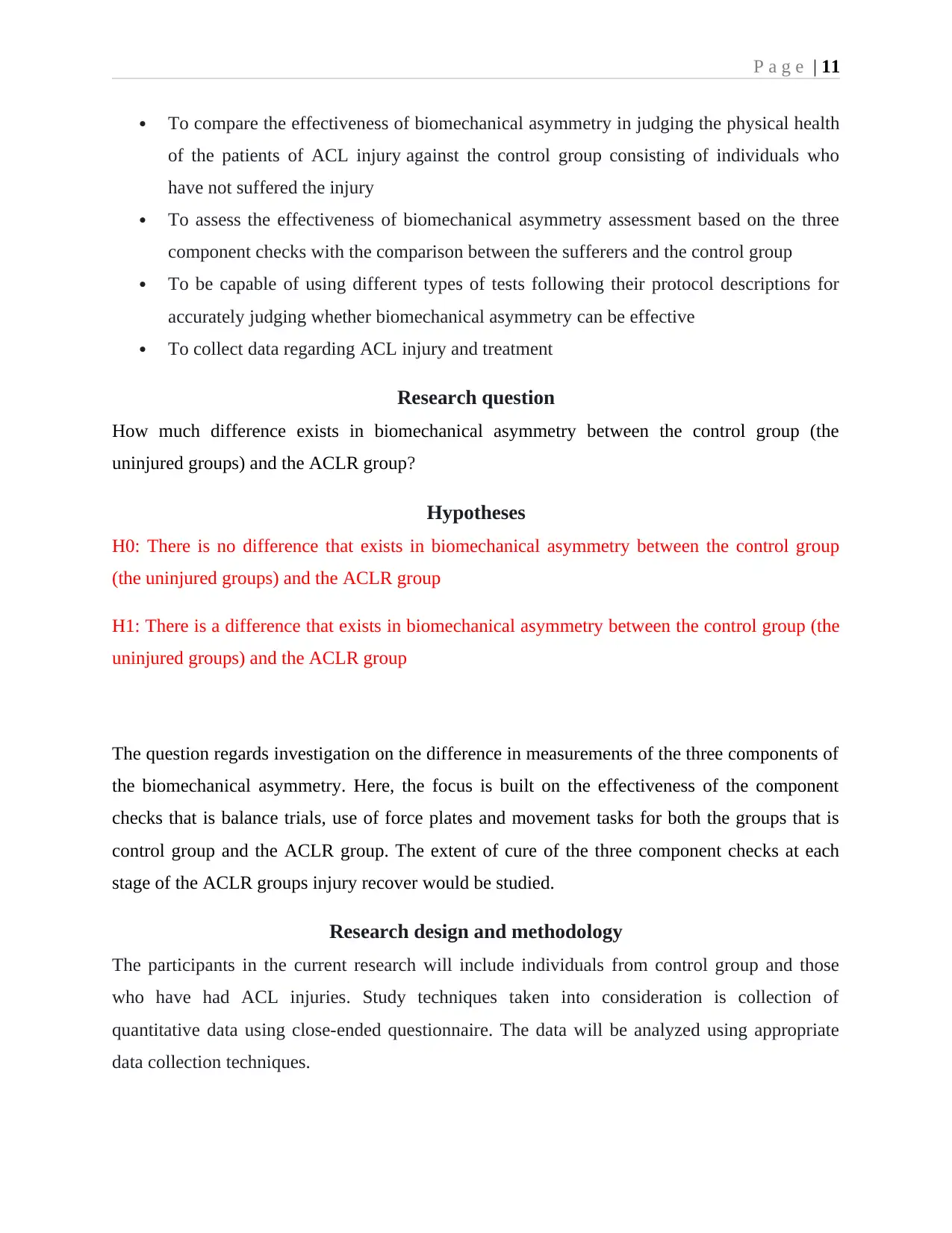
P a g e | 11
To compare the effectiveness of biomechanical asymmetry in judging the physical health
of the patients of ACL injury against the control group consisting of individuals who
have not suffered the injury
To assess the effectiveness of biomechanical asymmetry assessment based on the three
component checks with the comparison between the sufferers and the control group
To be capable of using different types of tests following their protocol descriptions for
accurately judging whether biomechanical asymmetry can be effective
To collect data regarding ACL injury and treatment
Research question
How much difference exists in biomechanical asymmetry between the control group (the
uninjured groups) and the ACLR group?
Hypotheses
H0: There is no difference that exists in biomechanical asymmetry between the control group
(the uninjured groups) and the ACLR group
H1: There is a difference that exists in biomechanical asymmetry between the control group (the
uninjured groups) and the ACLR group
The question regards investigation on the difference in measurements of the three components of
the biomechanical asymmetry. Here, the focus is built on the effectiveness of the component
checks that is balance trials, use of force plates and movement tasks for both the groups that is
control group and the ACLR group. The extent of cure of the three component checks at each
stage of the ACLR groups injury recover would be studied.
Research design and methodology
The participants in the current research will include individuals from control group and those
who have had ACL injuries. Study techniques taken into consideration is collection of
quantitative data using close-ended questionnaire. The data will be analyzed using appropriate
data collection techniques.
To compare the effectiveness of biomechanical asymmetry in judging the physical health
of the patients of ACL injury against the control group consisting of individuals who
have not suffered the injury
To assess the effectiveness of biomechanical asymmetry assessment based on the three
component checks with the comparison between the sufferers and the control group
To be capable of using different types of tests following their protocol descriptions for
accurately judging whether biomechanical asymmetry can be effective
To collect data regarding ACL injury and treatment
Research question
How much difference exists in biomechanical asymmetry between the control group (the
uninjured groups) and the ACLR group?
Hypotheses
H0: There is no difference that exists in biomechanical asymmetry between the control group
(the uninjured groups) and the ACLR group
H1: There is a difference that exists in biomechanical asymmetry between the control group (the
uninjured groups) and the ACLR group
The question regards investigation on the difference in measurements of the three components of
the biomechanical asymmetry. Here, the focus is built on the effectiveness of the component
checks that is balance trials, use of force plates and movement tasks for both the groups that is
control group and the ACLR group. The extent of cure of the three component checks at each
stage of the ACLR groups injury recover would be studied.
Research design and methodology
The participants in the current research will include individuals from control group and those
who have had ACL injuries. Study techniques taken into consideration is collection of
quantitative data using close-ended questionnaire. The data will be analyzed using appropriate
data collection techniques.
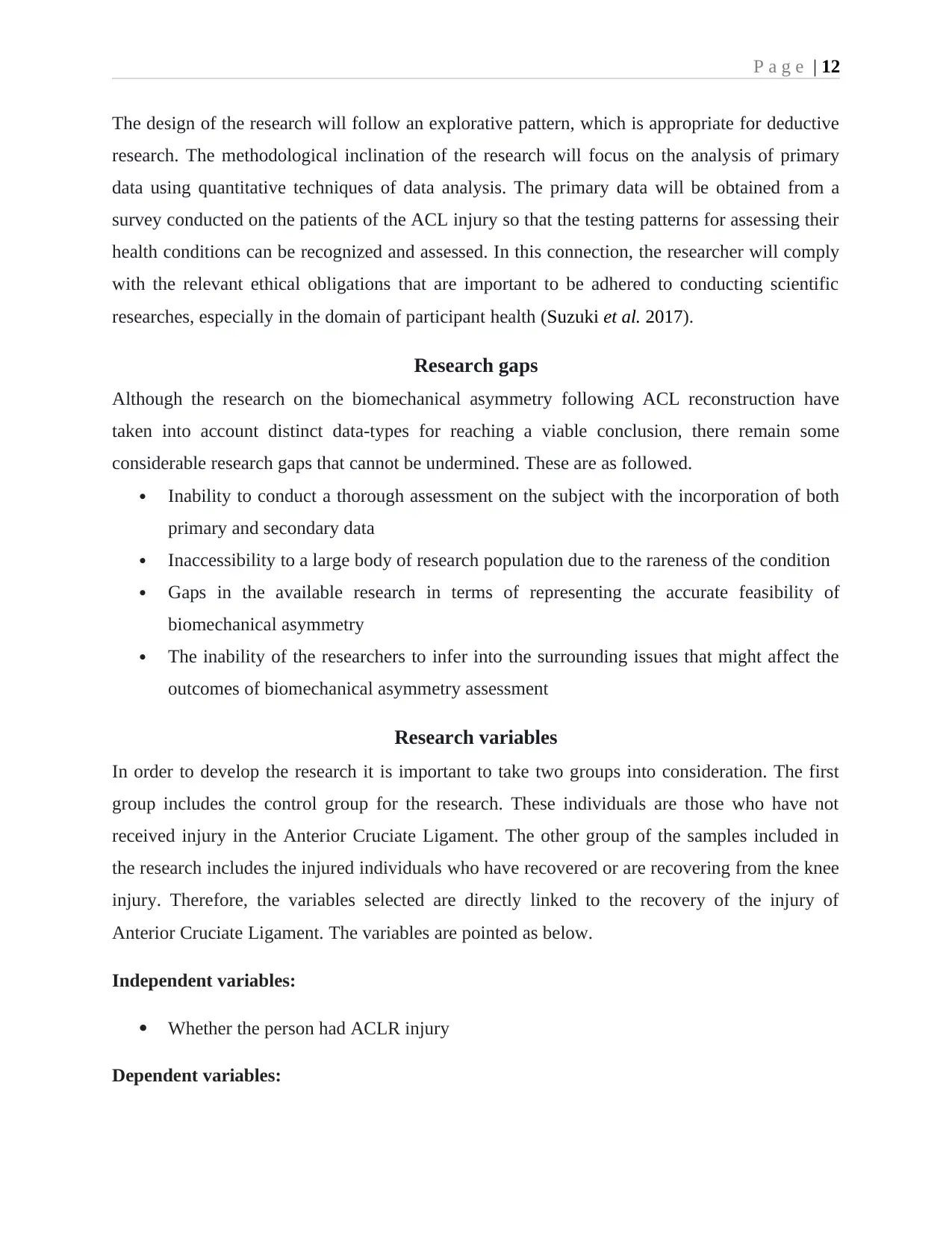
P a g e | 12
The design of the research will follow an explorative pattern, which is appropriate for deductive
research. The methodological inclination of the research will focus on the analysis of primary
data using quantitative techniques of data analysis. The primary data will be obtained from a
survey conducted on the patients of the ACL injury so that the testing patterns for assessing their
health conditions can be recognized and assessed. In this connection, the researcher will comply
with the relevant ethical obligations that are important to be adhered to conducting scientific
researches, especially in the domain of participant health (Suzuki et al. 2017).
Research gaps
Although the research on the biomechanical asymmetry following ACL reconstruction have
taken into account distinct data-types for reaching a viable conclusion, there remain some
considerable research gaps that cannot be undermined. These are as followed.
Inability to conduct a thorough assessment on the subject with the incorporation of both
primary and secondary data
Inaccessibility to a large body of research population due to the rareness of the condition
Gaps in the available research in terms of representing the accurate feasibility of
biomechanical asymmetry
The inability of the researchers to infer into the surrounding issues that might affect the
outcomes of biomechanical asymmetry assessment
Research variables
In order to develop the research it is important to take two groups into consideration. The first
group includes the control group for the research. These individuals are those who have not
received injury in the Anterior Cruciate Ligament. The other group of the samples included in
the research includes the injured individuals who have recovered or are recovering from the knee
injury. Therefore, the variables selected are directly linked to the recovery of the injury of
Anterior Cruciate Ligament. The variables are pointed as below.
Independent variables:
Whether the person had ACLR injury
Dependent variables:
The design of the research will follow an explorative pattern, which is appropriate for deductive
research. The methodological inclination of the research will focus on the analysis of primary
data using quantitative techniques of data analysis. The primary data will be obtained from a
survey conducted on the patients of the ACL injury so that the testing patterns for assessing their
health conditions can be recognized and assessed. In this connection, the researcher will comply
with the relevant ethical obligations that are important to be adhered to conducting scientific
researches, especially in the domain of participant health (Suzuki et al. 2017).
Research gaps
Although the research on the biomechanical asymmetry following ACL reconstruction have
taken into account distinct data-types for reaching a viable conclusion, there remain some
considerable research gaps that cannot be undermined. These are as followed.
Inability to conduct a thorough assessment on the subject with the incorporation of both
primary and secondary data
Inaccessibility to a large body of research population due to the rareness of the condition
Gaps in the available research in terms of representing the accurate feasibility of
biomechanical asymmetry
The inability of the researchers to infer into the surrounding issues that might affect the
outcomes of biomechanical asymmetry assessment
Research variables
In order to develop the research it is important to take two groups into consideration. The first
group includes the control group for the research. These individuals are those who have not
received injury in the Anterior Cruciate Ligament. The other group of the samples included in
the research includes the injured individuals who have recovered or are recovering from the knee
injury. Therefore, the variables selected are directly linked to the recovery of the injury of
Anterior Cruciate Ligament. The variables are pointed as below.
Independent variables:
Whether the person had ACLR injury
Dependent variables:
⊘ This is a preview!⊘
Do you want full access?
Subscribe today to unlock all pages.

Trusted by 1+ million students worldwide
1 out of 26
Your All-in-One AI-Powered Toolkit for Academic Success.
+13062052269
info@desklib.com
Available 24*7 on WhatsApp / Email
![[object Object]](/_next/static/media/star-bottom.7253800d.svg)
Unlock your academic potential
Copyright © 2020–2026 A2Z Services. All Rights Reserved. Developed and managed by ZUCOL.

